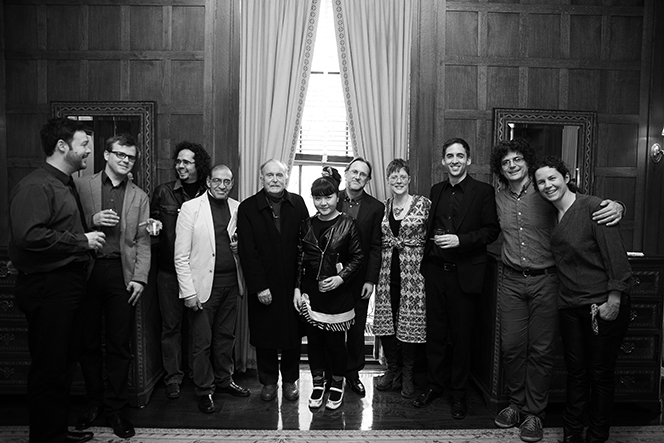photo: Amanda Lucier
Presenting a three day portrait of Alvin Lucier's music in the galleries of the Museum of Contemporary Art (with Lucier's presence and support!!) is a dream project, even when compared to all of the dream projects that I get to work on everyday with ICE. Alvin's music is packed with an infectious imagination. Many of Lucier's scores are text descriptions of a simple musical process. That these descriptions leap to life as engaging music is an orchestrational feat, akin to a composer writing a rich orchestral score at the piano.
In picking music for three days of concerts, naturally we wanted to include pieces that are favorites of the ICE players, pieces that were written for ICE by Lucier, and music that works together to give a picture of the huge range of styles and sensibilities we want people to hear and enjoy the span of his works.
I think the pieces on these programs work constructively in a musical conversation to highlight three major facets of Lucier's work. Naturally, we had to start with the piece that has become one of the defining landmarks on the path of American experimental music, I am sitting in a room, where a recording of Lucier's reciting a phrase is continually played back and re-recorded until the sounds begin to take on the acoustical properties of the room itself, rather than the human voice.
He is a master of sound and space, and his purely instrumental pieces, such as Codex and Miniature for Clarinet and Cello, convey a deep connection with the rich musical and expressive capabilities of these instruments. Lucier's instrumental works expand the concept of "chamber music"—they are not written simply to be heard in a room, but they interact meaningfully with the room, and the people and things within it.
The interaction of people with objects is a common theme of Lucier's music. A pianist plays the Beatles' "Strawberry Fields Forever," records it, and plays it back in a resonant teapot in Nothing is Real (Strawberry Fields Forever), creating a haunting effect that highlights the sonic properties of both the teapot and the piano. In Music for Cello with One or More Amplified Vases, the pure tones of the cello sets vases of various sizes vibrating and producing their own sounds.
Rather than focusing on the limited expressive abilities of electronics, Lucier finds novel ways for musicians to interact with electronics. Spira Mirabilisand Directions of Sounds from the Bridge use light controllers to highlight the very physical connection between light and sound. In Memoriam Jon Higgins and Charles Curtis are two of many in a series of pieces that explore the interactions of expressive human musicians with electronic tone generators. In Silver Streetcar for the Orchestra (1988), a percussionist plays a single metal triangle which becomes a complex world of sound when amplified. Levy Lorenzo has worked closely with Lucier to construct and resurrect some of the electronics, light and sound objects that are featured in these programs. His voice as a musician and engineer are heard throughout many of the pieces on these concerts.
Lucier's music is entrancing and engrossing. Hearing Lucier's music live is an experience that calls special and surprising attention to the sounds around us. But they are not random sounds culled from the environment—they are organized and prepared sounds that are crafted by a composer with an acute understanding of what happens to music between the moment it leaves a sound-producing instrument and reaches our ears.
Lucier chooses to notate his music in different ways—conventional music notation, spacial scores, and text descriptions. They ordinarily describe a simple process that reveals a novel and often ingenious musical environment. In that spirit, here are some simple descriptions of the pieces on our programs. Like descriptions of an artwork at a museum, they are not essential for the experiential enjoyment of the music; we've included them as roadmaps for our shows, for a closer understanding of what may be seen, heard and felt in these pieces.
ICE members and Alvin Lucier at The Americas Society in April 2013.
I am sitting in a room, Alvin Lucier and electronics (1969), 20"
Alvin Lucier sits in a room and records a passage of text into a tape machine. He then plays the recording back from the tape machine into the room. He records that playback with a microphone on the tape machine. He continues to play and record the results of successive recordings until the reverberant qualities of the room become so saturated that speech is indecipherable. As the degradation of the original progresses, beautiful results emerge from the noise.
Music for Snare Drum, Pure Wave Oscillator, and One or More Reflective Surfaces (1990), 15"
Sound travels through space in precise directions. It bounces, overlaps, reinforces, and destroys itself. In the piece, sound is aimed at a smooth reflective surface. Like aiming a light beam at a mirror, the sound echoes from the surface toward a snare drum which vibrates sympathetically. Like much of Alvin Lucier’s music, the piece exhibits a physical behavior while also yielding a satisfying musical phenomenon.
Miniature for Clarinet and Cello (2009), 2"
Miniature was premiered by the New York Miniaturist Ensemble, a group dedicated to commissioning and performing music containing one hundred notes or less. Lucier, skilled at making more from less, rises to this challenge. The clarinet and cello travel on a slow musical trajectory, first towards each other, then away. The texture is punctuated by silences that track the proportional distance of the two instruments.
Music for Piano with One or More Snare Drums (1992), 10"
A pianist varies and permutes a series of austere—even nostalgic—piano melodies that excite snare drums placed strategically throughout the space. The piece draws attention to the physical action of invisible sounds travelling from the source of a vibrating string to the ear; every location in the room gets a unique sonic experience.
Music for Cello with One or More Amplified Vases (1992), 13"
Vases sit on the floor as a nearby cello produces tones that cause the columns of air inside the vases to vibrate in different ways. Vases, with their varied and curved anatomy, have sonic properties that are more complex than other vessels. Microphones make the vibrations through the vases audible. Some vases have many nodes of vibration that correspond with notes on the cello, some just have one.
Spira Mirabilis, for bass sustaining instrument and electric light (1994), 8"
Most light bulbs pulsate at a frequency that represents a B-natural when converted into sound. Bassoonist Rebekah Heller explores the endurance of her breath and steadiness of her tone by pitting it against the relentless and incessant tone of a fluorescent tube.
Codex, soprano, violin, oboe, guitar, cello, clarinet in Bb (2013), 10"
Codex is a reference to the Codex Trujillo del Perú, a collection of manuscripts that are oldest known pieces of written music from the American continents. Lucier uses the first six notes of one of the pieces, Lanchas para baylar, as a starting point for his piece. In doing so, he breaks a simple melody into component parts, extending them acoustically with voice, breath and strings. Codex was commissioned by the Americas Society through Meet the Composer's Commissioning Music/USA program, and premiered by ICE.
In Memoriam Jon Higgins, for clarinet and pure wave oscillator (1984), 20"
A clarinet plays pure tones while an even purer, electrically-generated tone rises to meet it. The result are rhythmic interferences that seem to spin around the room, bouncing off of walls and ears. Jon Higgins (1939-1984) was a musicologist and scholar of Carnatic music, and a colleague of Mr. Lucier at Wesleyan University.
Still and Moving Lines of Silence in Families of Hyperbolas (1973-1974, rev. 2013), 15"
A small ensemble of soloists explores the acoustic phenomena of gliding their own instrumental sounds against steady, pure sine tones. The physical phenomenon of the sound waves bouncing in space are highlighted by lights, carried throughout the room, activated at sound "nodes"—intersections of conflicting sound waves. The result highlights the beautiful, yet simple mathematical relationships of sounds from the precisely controlled imperfection of the human performer against the perfect electronic signal.
Directions of Sounds from the Bridge, sound installation and performance for stringed instrument, audio oscillator and sound-sensitive lights (1978), 11"
The body of the violin becomes a speaker and a resonator as a transducer is attached directly to the instrument’s bridge. The directionality of different frequencies emanating at drastically different angles from the instrument is reflected visually using a custom installation of sound sensitive lights. What is seen is the representation of sound moving in different directions around the room.
Music for Pure Waves, Bass Drums and Acoustic Pendulums (1980), 10"
Four large orchestral bass drums are placed on a table. Hanging millimeters in front of each large drumhead is a ping pong ball on a long pendulum of fishing line from the ceiling. When carefully positioned, loudspeakers activate the drums heads, the ping pong balls bounce from the drum head, swing, and strike the bass drums to create unpredictable rumbles and rhythms that are entrancing to see and hear.
Nothing is Real (Strawberry Fields Forever), for piano, amplified teapot, tape recorder and miniature sound system (1990), 9"
A familiar tune is played, humbly, by a pianist. The same tune is transformed in a second iteration, exploiting the rich resonance of the piano's many strings.
Charles Curtis, for cello with slow sweep pure wave oscillators (2002), 14"
Long, double-stop tones on the cello react with pure wave oscillators to create dynamic, rhythmic textures of constructive and destructive interference between acoustic and electronic realms. Curtis, for whom the piece is named, is a contemporary cellist who has worked closely with Mr. Lucier.
Still Lives, for piano and sine waves (1995), 10"
Dedicated to acclaimed contemporary pianist Joseph Kubera, this piece explores the sound of piano gestures against multiple moving sine tones in eight short movements.
Carbon Copies, for saxophone, piano, percussion, and environmental recordings (1989), 20"
Three musicians gather field recordings from an exterior environment. These recordings are played through loudspeakers to the audience and through headphones to the musicians: a percussionist, a saxophonist, and a pianist. Slowly, the loudspeakers fade out while the sound in the headphones maintains. The performers attempt to emulate the natural sounds from the field recordings in real-time; the I is that the field recordings fade imperceptibly into their instrumental simulacra.
Silver Street Car for the Orchestra, for amplified solo triangle (1988), 8"
Though often the subject of jokes, an orchestral triangle is a rich and sonorous instrument. When performed by a disciplined and virtuosic percussionist, the number of sounds it yields are surprising. Lucier’s Silver Street Car for the Orchestra explores the entire scope of the triangle’s offerings with the assistance of a precisely aimed microphone. Tones shimmer and dance throughout the space, and what seem like innocent repetitions become a complex web harmonies and melodies.


